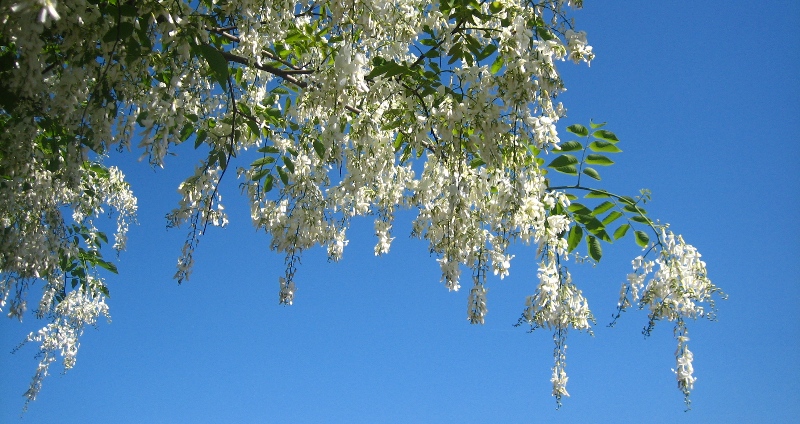THE LEAFLET

Tree of the Month: American Yellowwood
Our Tree of the Month for July is the Yellowwood (Cladrastric kentukea), also called the Kentucky Yellowwood and American Yellowwood. A tree unknown to many, the Yellowwood has been making headway as a multi-functional landscape tree. It is surprising that it has not been more popular, as the Yellowwood combines the best traits of a number of other trees. Like the Zelkova tree, its branches gracefully diverge relatively low on the trunk to swoop overhead and provide you with some shade. Like an ornamental wisteria, the Yellowwood’s flowers are borne in long stunning chains, beginning around May or June. Like the Hickory tree, Yellowwood’s leaves are large and impressive with a compound structure and turn a lovely yellow in the fall. Like the American Beech, Yellowwood’s bark remains smooth with an appealing lighter gray color. Not bad for a single tree, eh? And this tree’s size weighs in at Goldilocks’ happy medium. At around 30 to 50 feet at maturity, it is just large enough to provide the shade our houses need and the tree cover our city needs, yet of a size that can fit well where larger trees often cannot.

Yellowwood’s native range is narrow, stretching from the Carolina’s west to Oklahoma. And even within that, Yellowwood only occurs in pockets across each state. There is some evidence that suggests that Yellowwood’s natural range is actually decreasing further. Who knows how far it might have ranged in centuries past, or if its range will continue to recede? The good news is that, under cultivation by gardeners and landscapers, Yellowwood can be grown in most parts of the U.S. One might say that it is our duty to the ecological heritage of our land to cultivate this tree and ensure that it thrives. In the wild, Yellowwoods enjoy well drained, moist, rich soils, but under cultivation it has been known to do well in a variety of conditions (as long as it has enough sun). Full sun is ideal. Yellowwood is also known to cope well with air pollution and urban conditions.
So Yellowwood is an ideal landscape tree large enough to provide substantial benefits to the urban environment…what else do you need to know about it? Well, you must be wondering “is the wood actually yellow?” Yes – in fact, people at one time extracted a dye from it; it was also used in choice wood craft applications, like turnery and gunstock making. And for you avid botanists or vegetables gardeners, you might have looked close enough at the individual flowers to have realized they look awfully similar to pea flowers. Again, not a coincidence as this tree is indeed in the pea family, along with redbud, honey locust, and others. However, Yellowwood does not provide the nitrogenous boon to the soil as do other members of the pea family. But surely by now you have left your computer screen and are already outside in your yard trying to decide, ‘where will I plant a Yellowwood of my own?” I will distract you no more from the task at hand!
Flickr credit: Tom Gill.